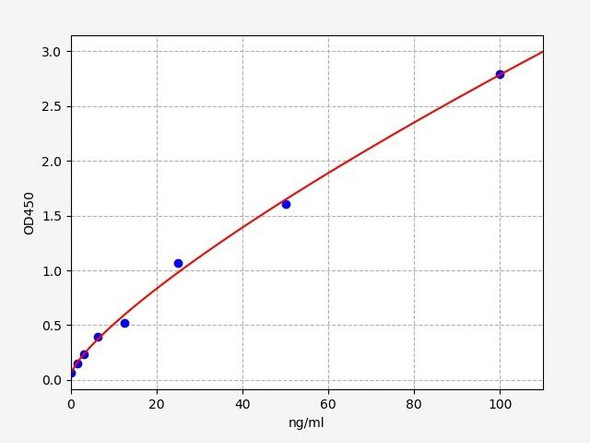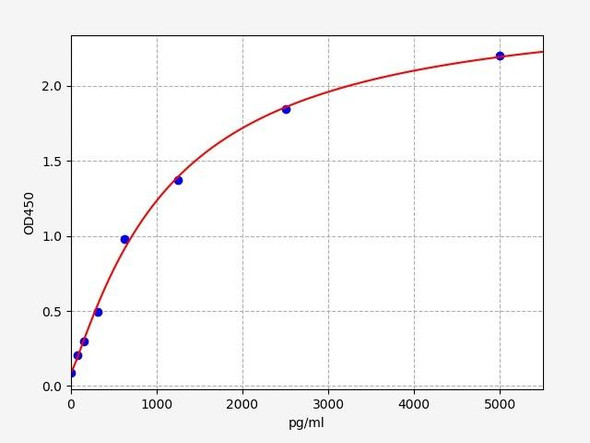Mouse MMP 9 ELISA Kit
- SKU:
- MOFI00077
- Product Type:
- ELISA Kit
- Size:
- 96 Assays
- Uniprot:
- P41245
- Sensitivity:
- 46.875pg/ml
- Range:
- 78.125-5000pg/ml
- ELISA Type:
- Sandwich ELISA, Double Antibody
- Synonyms:
- MMP-9, Matrix Metalloproteinase 9, CLG4B, Gelatinase B, GELB, CLG4B, macrophage gelatinase, MANDP2, MMP-9, type V collagenase
- Reactivity:
- Mouse
Description
| Product Name: | Mouse MMP 9 ELISA Kit |
| Product Code: | MOFI00077 |
| Size: | 96 Assays |
| Alias: | MMP-9, Matrix Metalloproteinase 9, CLG4B, Gelatinase B, GELB, CLG4B, macrophage gelatinase, MANDP2, MMP-9, type V collagenase |
| Detection Method: | Sandwich ELISA |
| Application: | This immunoassay kit allows for the in vitro quantitative determination of Mouse MMP-9 concentrations in serum plasma and other biological fluids. |
| Sensitivity: | 46.875pg/ml |
| Range: | 78.125-5000pg/ml |
| Storage: | 4°C for 6 months |
| Note: | For Research Use Only |
| Recovery: | Matrices listed below were spiked with certain level of Mouse MMP-9 and the recovery rates were calculated by comparing the measured value to the expected amount of Mouse MMP-9 in samples. | ||||||||||||||||
| |||||||||||||||||
| Linearity: | The linearity of the kit was assayed by testing samples spiked with appropriate concentration of Mouse MMP-9 and their serial dilutions. The results were demonstrated by the percentage of calculated concentration to the expected. | ||||||||||||||||
| |||||||||||||||||
| Intra Assay: | CV <8% | ||||||||||||||||
| Inter Assay: | CV <10% |
| Component | Quantity | Storage |
| ELISA Microplate (Dismountable) | 8-12 strips | 4°C for 6 months |
| Lyophilized Standard | 2 | 4°C/-20°C |
| Sample/Standard Dilution Buffer | 20ml | 4°C |
| Biotin-labeled Antibody(Concentrated) | 120ul | 4°C (Protect from light) |
| Antibody Dilution Buffer | 10ml | 4°C |
| HRP-Streptavidin Conjugate(SABC) | 120ul | 4°C (Protect from light) |
| SABC Dilution Buffer | 10ml | 4°C |
| TMB Substrate | 10ml | 4°C (Protect from light) |
| Stop Solution | 10ml | 4°C |
| Wash Buffer(25X) | 30ml | 4°C |
| Plate Sealer | 5 | - |
Other materials and equipment required:
- Microplate reader with 450 nm wavelength filter
- Multichannel Pipette, Pipette, microcentrifuge tubes and disposable pipette tips
- Incubator
- Deionized or distilled water
- Absorbent paper
- Buffer resevoir
| Uniprot | P41245 |
| UniProt Protein Function: | MMP9: May play an essential role in local proteolysis of the extracellular matrix and in leukocyte migration. Could play a role in bone osteoclastic resorption. Cleaves KiSS1 at a Gly-|-Leu bond. Cleaves type IV and type V collagen into large C-terminal three quarter fragments and shorter N-terminal one quarter fragments. Degrades fibronectin but not laminin or Pz-peptide. Exists as monomer or homodimer; disulfide-linked. Exists also as heterodimer with a 25 kDa protein. Macrophages and transformed cell lines produce only the monomeric form. Interacts with ECM1. Activated by 4-aminophenylmercuric acetate and phorbol ester. Up-regulated by ARHGEF4, SPATA13 and APC via the JNK signaling pathway in colorectal tumor cells. Produced by normal alveolar macrophages and granulocytes. Inhibited by histatin-3 1/24 (histatin-5). Inhibited by ECM1. Belongs to the peptidase M10A family. |
| UniProt Protein Details: | Protein type:Protease; Secreted; Motility/polarity/chemotaxis; EC 3.4.24.35; Secreted, signal peptide Cellular Component: extracellular matrix; extracellular space; proteinaceous extracellular matrix; protein complex; extracellular region Molecular Function:peptidase activity; identical protein binding; zinc ion binding; hydrolase activity; metallopeptidase activity; fibronectin binding; metal ion binding; metalloendopeptidase activity; endopeptidase activity; protein complex binding Biological Process: positive regulation of keratinocyte migration; response to drug; ossification; extracellular matrix organization and biogenesis; positive regulation of apoptosis; positive regulation of leukocyte migration; tissue remodeling; positive regulation of synaptic plasticity; proteolysis; protein oligomerization; collagen catabolic process; positive regulation of angiogenesis; negative regulation of fibroblast proliferation; response to oxidative stress; leukocyte migration; skeletal development; embryo implantation; transformation of host cell by virus |
| UniProt Code: | P41245 |
| NCBI GenInfo Identifier: | 341940960 |
| NCBI Gene ID: | 17395 |
| NCBI Accession: | P41245.2 |
| UniProt Secondary Accession: | P41245,Q06788, Q80XI8, Q9DC02, |
| UniProt Related Accession: | P41245 |
| Molecular Weight: | 80,535 Da |
| NCBI Full Name: | Matrix metalloproteinase-9 |
| NCBI Synonym Full Names: | matrix metallopeptidase 9 |
| NCBI Official Symbol: | Mmp9 |
| NCBI Official Synonym Symbols: | Clg4b; MMP-9; B/MMP9; AW743869; pro-MMP-9 |
| NCBI Protein Information: | matrix metalloproteinase-9; GELB; Gel B; gelatinase B; 92kD gelatinase; 92kDa gelatinase; 92 kDa gelatinase; collagenase type IVB; 92kD type IV collagenase; 92kDa type IV collagenase; 92 kDa type IV collagenase; matrix metalloproteinase 9 |
| UniProt Protein Name: | Matrix metalloproteinase-9 |
| UniProt Synonym Protein Names: | 92 kDa gelatinase; 92 kDa type IV collagenase; Gelatinase B; GELB |
| Protein Family: | Matrix metalloproteinase |
| UniProt Gene Name: | Mmp9 |
| UniProt Entry Name: | MMP9_MOUSE |
*Note: Protocols are specific to each batch/lot. For the correct instructions please follow the protocol included in your kit.
| Step | Procedure |
| 1. | Set standard, test sample and control (zero) wells on the pre-coated plate respectively, and then, record their positions. It is recommended to measure each standard and sample in duplicate. Wash plate 2 times before adding standard, sample and control (zero) wells! |
| 2. | Aliquot 0.1ml standard solutions into the standard wells. |
| 3. | Add 0.1 ml of Sample / Standard dilution buffer into the control (zero) well. |
| 4. | Add 0.1 ml of properly diluted sample (Human serum, plasma, tissue homogenates and other biological fluids.) into test sample wells. |
| 5. | Seal the plate with a cover and incubate at 37 °C for 90 min. |
| 6. | Remove the cover and discard the plate content, clap the plate on the absorbent filter papers or other absorbent material. Do NOT let the wells completely dry at any time. Wash plate X2. |
| 7. | Add 0.1 ml of Biotin- detection antibody working solution into the above wells (standard, test sample & zero wells). Add the solution at the bottom of each well without touching the side wall. |
| 8. | Seal the plate with a cover and incubate at 37°C for 60 min. |
| 9. | Remove the cover, and wash plate 3 times with Wash buffer. Let wash buffer rest in wells for 1 min between each wash. |
| 10. | Add 0.1 ml of SABC working solution into each well, cover the plate and incubate at 37°C for 30 min. |
| 11. | Remove the cover and wash plate 5 times with Wash buffer, and each time let the wash buffer stay in the wells for 1-2 min. |
| 12. | Add 90 µL of TMB substrate into each well, cover the plate and incubate at 37°C in dark within 10-20 min. (Note: This incubation time is for reference use only, the optimal time should be determined by end user.) And the shades of blue can be seen in the first 3-4 wells (with most concentrated standard solutions), the other wells show no obvious color. |
| 13. | Add 50 µL of Stop solution into each well and mix thoroughly. The color changes into yellow immediately. |
| 14. | Read the O.D. absorbance at 450 nm in a microplate reader immediately after adding the stop solution. |
When carrying out an ELISA assay it is important to prepare your samples in order to achieve the best possible results. Below we have a list of procedures for the preparation of samples for different sample types.
| Sample Type | Protocol |
| Serum: | If using serum separator tubes, allow samples to clot for 30 minutes at room temperature. Centrifuge for 10 minutes at 1,000x g. Collect the serum fraction and assay promptly or aliquot and store the samples at -80°C. Avoid multiple freeze-thaw cycles. If serum separator tubes are not being used, allow samples to clot overnight at 2-8°C. Centrifuge for 10 minutes at 1,000x g. Remove serum and assay promptly or aliquot and store the samples at -80°C. Avoid multiple freeze-thaw cycles. |
| Plasma: | Collect plasma using EDTA or heparin as an anticoagulant. Centrifuge samples at 4°C for 15 mins at 1000 - g within 30 mins of collection. Collect the plasma fraction and assay promptly or aliquot and store the samples at -80°C. Avoid multiple freeze-thaw cycles. Note: Over haemolysed samples are not suitable for use with this kit. |
| Urine & Cerebrospinal Fluid: | Collect the urine (mid-stream) in a sterile container, centrifuge for 20 mins at 2000-3000 rpm. Remove supernatant and assay immediately. If any precipitation is detected, repeat the centrifugation step. A similar protocol can be used for cerebrospinal fluid. |
| Cell culture supernatant: | Collect the cell culture media by pipette, followed by centrifugation at 4°C for 20 mins at 1500 rpm. Collect the clear supernatant and assay immediately. |
| Cell lysates: | Solubilize cells in lysis buffer and allow to sit on ice for 30 minutes. Centrifuge tubes at 14,000 x g for 5 minutes to remove insoluble material. Aliquot the supernatant into a new tube and discard the remaining whole cell extract. Quantify total protein concentration using a total protein assay. Assay immediately or aliquot and store at ≤ -20°C. |
| Tissue homogenates: | The preparation of tissue homogenates will vary depending upon tissue type. Rinse tissue with 1X PBS to remove excess blood & homogenize in 20ml of 1X PBS (including protease inhibitors) and store overnight at ≤ -20°C. Two freeze-thaw cycles are required to break the cell membranes. To further disrupt the cell membranes you can sonicate the samples. Centrifuge homogenates for 5 mins at 5000xg. Remove the supernatant and assay immediately or aliquot and store at -20°C or -80°C. |
| Tissue lysates: | Rinse tissue with PBS, cut into 1-2 mm pieces, and homogenize with a tissue homogenizer in PBS. Add an equal volume of RIPA buffer containing protease inhibitors and lyse tissues at room temperature for 30 minutes with gentle agitation. Centrifuge to remove debris. Quantify total protein concentration using a total protein assay. Assay immediately or aliquot and store at ≤ -20 °C. |
| Breast Milk: | Collect milk samples and centrifuge at 10,000 x g for 60 min at 4°C. Aliquot the supernatant and assay. For long term use, store samples at -80°C. Minimize freeze/thaw cycles. |










